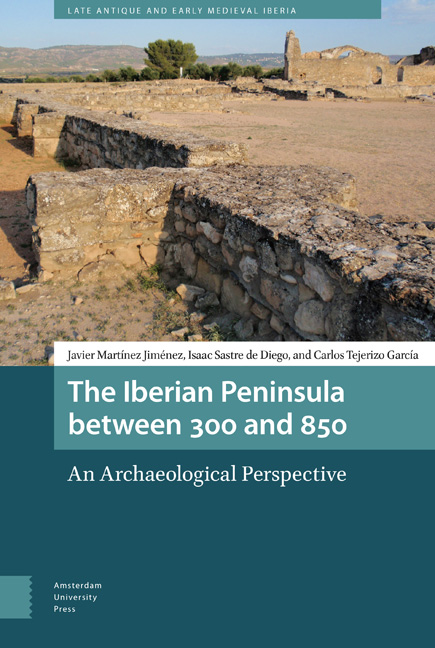Book contents
- Frontmatter
- Contents
- List of Figures
- Acknowledgements
- Preliminary notes
- Preface
- Introduction: An archaeological perspective on the Iberian peninsula between Rome and the Middle Ages
- Part 1 The Late Roman period
- Part 2 The post-Roman period
- Part 3 The Early Middle Ages
- Appendix 1 Site reference table
- Appendix 2 Maps
- Appendix 3 Lists of rulers
- Abbreviations
- Bibliography
- Index
4 - Christianization and Germanization: New evidence for current debates
Published online by Cambridge University Press: 10 December 2020
- Frontmatter
- Contents
- List of Figures
- Acknowledgements
- Preliminary notes
- Preface
- Introduction: An archaeological perspective on the Iberian peninsula between Rome and the Middle Ages
- Part 1 The Late Roman period
- Part 2 The post-Roman period
- Part 3 The Early Middle Ages
- Appendix 1 Site reference table
- Appendix 2 Maps
- Appendix 3 Lists of rulers
- Abbreviations
- Bibliography
- Index
Summary
Traditionally, both the conversion to Christianity and the arrival of the Barbarians have been considered the causes of change in the material culture of Late Antique Hispania. This was understood from the presence of new burial practices, new decorative motifs in architecture and jewellery, and the testimony of the written sources. Despite this, debate amongst scholars on the interpretation of these finds is still ongoing and, in many cases, highly controversial. This chapter intends to explain the way in which these two large transformations took place, how they can be observed through the material record, and what repercussions they had on the long-term changes of Late Antiquity.
Understanding Christianity through archaeology
Christianity is one of the most defining factors of Late Antiquity, because its influence went beyond religion and belief: it influenced the material culture, cult spaces and practices; it was even used as an added element of people's identities (Pohl 2013b). Beyond the impact of Christianity on Roman monumentality, urbanism, and burial practices (as discussed in Chapters 2 and 3), the archaeology of Christianity offers an extra dimension of analysis: how Christianity worked within late Roman society and how it functioned as a religion in its early centuries. The way it spread (geographically and socially) and how it appeared in the peninsula can be explained through the analysis of the material culture. Furthermore, the material culture can be studied from two perspectives: understanding it as the archaeology of Christianity (how the Christian cult worked physically) and the archaeology of Christians and their conversion (how Christianity became an extra layer of identity). It is in this context that the Archaeology of Liturgy, a recently developed method of analysis, has a key role in fully understanding the earliest traces of the Christian cult in the peninsula (Sastre de Diego 2013).
The first Christians
Archaeological evidence for Christianity and Christian material culture appeared in Hispania much later than the first literary mention of Christians in the Iberian peninsula. This is the famous Epistula 67 of Bishop Cyprian of Carthage, dated to 254, and addressed to the communities of Mérida and León-Astorga. Other than this, the first Hispanic recorded martyrdom (that of Bishop Fructuosus and his fellow bishops Augurius and Eulogius of Tarragona) also belongs to this same moment.
- Type
- Chapter
- Information
- The Iberian Peninsula between 300 and 850An Archaeological Perspective, pp. 125 - 150Publisher: Amsterdam University PressPrint publication year: 2018



